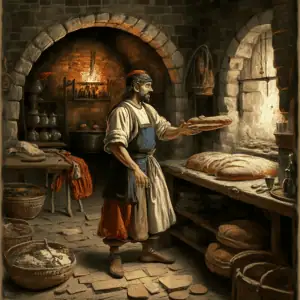In the medieval era, castles stood as imposing fortifications that safeguarded the realms of kings, lords, and nobles.
Within their sturdy stone walls, a complex system of defense was established, requiring a variety of specialized occupations to ensure the security and protection of these mighty structures.
From skilled warriors to vigilant sentinels, the jobs dedicated to defending castles played a vital role in the intricate web of medieval society.
Lord or Lady of the Castle
The lord or lady of the castle was responsible for overseeing the castle’s defenses and the safety of those inside. They would work with their advisors and the castle garrison to develop plans for defense and oversee the implementation of those plans.
Castellan
The castellan was the person in charge of the castle’s day-to-day operations, including overseeing the castle’s defenses. They would work with the lord or lady of the castle to develop and execute plans for defense, and oversee the castle garrison.
Commander of the Guard
The commander of the guard was responsible for leading the castle’s soldiers and coordinating their activities. They would work with the lord or lady of the castle and the castellan to develop plans for defense, and then ensure that those plans were carried out by the soldiers.
Archer
The archer was responsible for defending the castle’s walls and gates with a bow and arrow. They would be stationed at key locations around the castle and would be prepared to fire on any attackers who came within range.
Crossbowman
The crossbowman was responsible for defending the castle’s walls and gates with a crossbow. Crossbows were more powerful than bows and required less strength to use, so crossbowmen were often stationed in key locations where they could do the most damage to attackers.
Soldier
The soldier was responsible for defending the castle with a sword, spear, or other weapon. They would be stationed on the castle walls, gates, and in other key locations and would be prepared to engage in hand-to-hand combat with any attackers who breached the castle’s defenses.
Engineer
The engineer was responsible for designing and building the castle’s defenses, including walls, towers, and gates. They would work with the lord or lady of the castle, the castellan, and the commander of the guard to develop plans for defense and then oversee the construction of those plans.
Sapper
The sapper was responsible for undermining the castle’s walls and gates by digging tunnels underneath them. This job was dangerous, as sappers could be detected and killed by defenders or collapse the walls or gates they were trying to undermine.
Siege Engineer
The siege engineer was responsible for designing and building the castle’s siege engines, including trebuchets, battering rams, and siege towers. They would work with the lord or lady of the castle, the castellan, and the commander of the guard to develop plans for defense and then oversee the construction of those siege engines.
Watchman
The watchman was responsible for keeping watch over the castle at night and alerting the commander of the guard if any attackers were spotted. They would be stationed on the castle walls or in towers and would be responsible for sounding alarms if they saw anything suspicious.
Knights
Knights were the epitome of medieval chivalry and played a vital role in defending castles. Trained from an early age in the art of warfare, knights possessed exceptional combat skills, strategic acumen, and unwavering loyalty.
Clad in armor and wielding formidable weapons, they stood as the stalwart protectors of castles, defending the fortifications against enemy forces. Whether engaging in fierce battles, leading charges, or patrolling the castle walls, knights exemplified courage and honor, serving as the first line of defense.
Their unwavering dedication and martial prowess ensured that castles remained secure, preserving the realms of their lords and upholding the ideals of medieval knighthood.
Conclusion
The medieval jobs dedicated to defending castles were not merely occupations; they embodied a steadfast commitment to duty, honor, and loyalty. Through their unwavering vigilance, these individuals fortified the castles against external threats, safeguarding the realms within.
Their contributions were not only crucial to the defense of the physical structures but also to the preservation of the social order and the stability of medieval society as a whole.
The legacy of these castle defenders endures as a testament to their unwavering dedication and the enduring importance of their roles in the medieval world.











